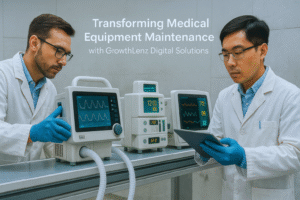In the FMCG world, speed is everything. Products move fast, demand shifts overnight, and margins are relentlessly thin. In such an environment, every inefficiency on the factory floor, every stoppage, every underutilized machine, every scrap product, directly eats into profitability.
That’s why asset lifecycle management has emerged as a strategic lever for competitive advantage. It’s not just about keeping machines running, it’s about running them smarter: maximizing uptime, improving efficiency, and cutting waste.
At GrowthLenz, we’ve seen how manufacturers who take asset management seriously can reduce costs by double digits while gaining flexibility to respond faster to market shifts. Let’s explore how.
1. Maximize Asset Utilization to Lower Unit Costs
Thin margins mean FMCG players must get the most out of every asset. Even small improvements in utilization make a big difference.
📌 Benchmark: Optimizing packaging lines from 75% to 85% utilization has been shown to lower unit costs by 8–12% without new investment.
When existing machines are fully leveraged, fixed costs (labor, depreciation, utilities) are spread across more units. This improves ROI on capital already in place.
2. Cut Downtime with Predictive Maintenance
Downtime is one of the biggest hidden costs in FMCG manufacturing. With high-speed lines and frequent SKU changes, the impact of unplanned stoppages is amplified.
Predictive maintenance, powered by IoT sensors, analytics, and AI, detects early signs of wear and intervenes before breakdowns occur.
Benchmarks:
- Manufacturers have reduced unplanned downtime by 30–40%
- Emergency maintenance costs fell by up to 58%
- Some plants reported ROI in under 12 months
The result is smoother production flow and healthier equipment with longer lifespans.
3. Build Flexibility with Faster Changeovers
FMCG thrives on variety: different flavors, sizes, packs, and regional variants. But frequent line changeovers can eat into capacity if not optimized.
Investing in modular, easy-to-configure equipment and fine-tuning changeover processes reduces idle time.
Benchmark: Plants that optimized changeovers cut transition times by 20–30%, translating into more uptime and improved responsiveness to shifting demand.
4. Enhance Energy Efficiency
Energy is a significant cost driver. Older, poorly maintained machines are often energy hogs. By upgrading equipment and using monitoring systems to track real-time consumption, companies can uncover hidden savings.
Benchmark: FMCG companies implementing energy-monitoring solutions reduced consumption per unit by 10–15%, while contributing directly to ESG goals.
This means lower utility bills, less waste, and progress toward carbon reduction commitments.
5. Minimize Waste and Quality Rejections
Poorly calibrated machines often lead to off-spec products, rework, or scrap. Not only is this costly, it also risks brand reputation.
Real-time quality monitoring and closed-loop feedback ensure production stays within specification.
Benchmark: Plants with advanced asset-driven quality checks reduced rework and scrap by 15–20%, saving millions annually in materials and packaging.
6. Empower Decisions with Real-Time Monitoring
Digital asset platforms give plant managers visibility they’ve never had before, live dashboards showing machine health, utilization, and energy use.
Benchmark: Sites using real-time OEE (Overall Equipment Effectiveness) tracking reported a 7% increase in throughput and halved downtime within a quarter.
This shift from reactive firefighting to proactive problem-solving creates a culture of continuous improvement.
7. Avoid Unnecessary Capital Expenditure
When capacity seems constrained, many companies rush to buy new machines. But often, the real problem is underutilization or poor maintenance.
By diagnosing bottlenecks and optimizing existing assets, manufacturers can defer or eliminate major CapEx.
Benchmark: Several FMCG plants extended equipment lifespans by 3–5 years through proactive asset management, saving millions in avoided purchases.
Real-World Impact
One FMCG manufacturer that adopted predictive maintenance and digital OEE tracking achieved:
- 20% reduction in downtime
- 10% cut in energy consumption
- 15% increase in throughput
Together, these improvements delivered a 7% reduction in per-unit manufacturing costs without investing in new machinery.
The GrowthLenz Perspective
Managing assets effectively is no longer just a maintenance function. It is a strategic enabler of efficiency, sustainability, and agility.
For FMCG companies, the path forward is clear:
- Start small with predictive maintenance on critical lines
- Leverage data to uncover hidden inefficiencies
- Scale gradually into a full digital asset management ecosystem
The payoff is not just cost savings. It is resilience, faster responsiveness to consumers, and a foundation for long-term competitive advantage.
In FMCG, time lost is money lost. Smarter asset management gives that time back.
Call to Action
At GrowthLenz, we partner with FMCG manufacturers to unlock efficiencies through digital asset management, helping them cut downtime, reduce energy use, and maximize returns from existing assets.
If you’re exploring ways to reduce costs and future-proof your operations, let’s connect. We’d be glad to share insights, benchmarks, and strategies tailored to your production challenges.









